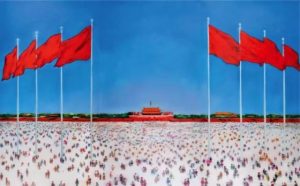
Yin Zhaoyang’s oil painting, Utopia-the Flags on the Square (2003), displays that the political environment has become more decentralized and open-minded after the Chinese Economic Reform in the late twentieth century. Through the illustration of the size of Tiananmen, the throng’s dispersed orientations, and the eight red flags, Yin conveys the idea that Tiananmen evolves from a political symbol of the absolute and centralized power into a sightseeing spot representing more of the cultural aspect of China
(message crossed from the artwork and the artist, got it).
The scale of Tiananmen in this painting makes Tiananmen relatively inconspicuous. Compared to the dense crowd and the bright red flags in the foreground, Tiananmen constitutes only the background of the artwork. Since the scale of the architecture is small, one can barely identify Mao’s portrait and the party’s slogan on Tiananmen. In this way, Yin indicates that Tiananmen does not emphasize its historical meaning as a prime site of political gathering anymore. Tiananmen in this painting blends into the wall of the Forbidden City in the background, restoring its original architectural function as a gate for the palace. To show the integrity and balance of Tiananmen with the palace, Yin adds other palace buildings with similar structures to Tiananmen behind the walls of the Forbidden City. Tiananmen thus displays its pure architectural function as one of the gates in the Forbidden City representing the long history of imperial China.
Yin further explores the notion of Tiananmen as a sightseeing spot rather than a place for political worshiping or demonstrations through the depiction of the blurred and dispersed crowd on the square. Yin employs the Richter painting style, which blurs the crowd into colorful moving patches. This vagueness leaves room for spectators to contemplate the diverse identity of visitors as they can be teenagers, elders, or foreigners. Instead of having a uniform orientation facing the authoritative symbol Tiananmen, the throng is dispersed and freely moving on the square. The crowd, therefore, embodies the gradually opened political environment and pluralistic society at the beginning of the twenty-first century. As visitors blithely bustling around the square without a common political identity, the political significance of Tiananmen becomes less important for them.
(this is a strong paragraph)
The orientation of the majestic red flags among the crowd posits the freedom of Chinese spirits and an open-minded society after the Chinese Economic Reform. The eight flags (why eight flags?) are idealized in Yin’s painting as the title Utopia-the Flags on the Square indicates. The flags on each side flutter in two different directions. The vividly fluttering flags that violate the laws of nature thus indicate the people in China does not necessarily need to follow one static and centralized rule but can have free and different political identity. The bright red flags are blank without any political symbol on it. This characteristic further explores Chinese cultural identity as the color red here stands purely for the traditional color of Chinese red. Since the title includes “Utopia”, which defines the idealized social and political scheme, these flags mark the bright future of China as becoming more and more liberal.
By embracing the insignificant scale of Tiananmen, the dispersed orientation and diverse identity of the crowd, and the idealized red flags on the square, Yin’s painting signifies Tiananmen’s diluted political symbol. This painting was created in 2003, twenty-five years after the Chinese Economic Reform. At that time, China gradually opened its door to the international market and embraced globalization. Yin evokes the positive feelings of the changing political environment as China progresses into the new era of modernization.
reading comments: have learned about possible meanings of the artwork through your analysis. if the central message is “utopia,” then the artist paints or visualizes the utopia in terms of composition, the flags, the gate of heavenly peace, the dotted masses …. you have nicely touched those elements. could turn the writing/analysis more formal.
